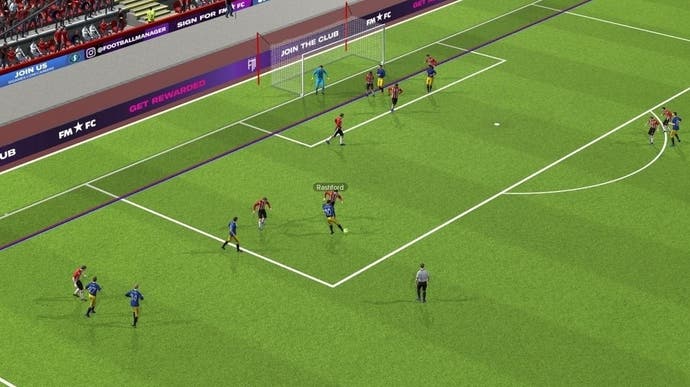Football Manager 2022 review - the obsession made real
Under pressure.
Let's get the shameful business out of the way first. Every year on Football Manager, I choose to manage Manchester United. United - or, ahem, Man UFC - are the team I support here in the real world, and that's about as far as my thought process goes when starting up a new FM save. There are two philosophies, basically: the fashionable, hipster choice of managing somewhere a little trendy, a little half-step out of the limelight, an AS Saint-Étienne, maybe, or for a greater challenge someone like AFC Wimbledon or your local ultra-underdogs of choice; or, you manage the team you support. There is technically a third way which we don't speak about (PSG), but broadly speaking, those are your options.
The reason I like Manchester United is because they straddle a bit of both. I know the club inside out, I'm desperate for us to win and loathe to see City win the race for another five attacking midfielders ahead of us, and frankly I just like having all my dreams fulfilled. At the same time Manchester United is a god awful mess of a club, and it brings me immeasurable joy to step into the breach every year and be the hero who comes and fixes it. So, like I said, best of both: favourite-team fantasy plus the pleasure of mending that which is fundamentally broken.
Where does Football Manager 2022 come in? Well, this year more than any other year before it has truly captured the experience of modern football management at the very top of the game. To both my immense joy and my not-insignificant anguish, playing FM22 makes me feel exactly like Ole Gunnar Solskjaer.
I'll come back to that, but first let's backpedal a bit. FM22 has changed more than you might expect at first glance, through a series of subtle but highly impactful tweaks to how things work under the hood. The biggest of those is a somewhat revolutionary change in the match engine. Animations, in those many hundreds and thousands of 3D matches you played through in previous years, were actually tied to the classic 2D discs - as in the ones from the classic view that your mate who still calls it "Championship Manager" insists on using. Now, according to developer Sports Interactive, players can move off of those discs in their animations. Most of the time this just results in a very pleasing curved run here or there, but it also enables things like Cruyff turns and more agile pivots for the players themselves - the type of thing you always thought was there but, if you went back to FM21, would suddenly notice as missing.
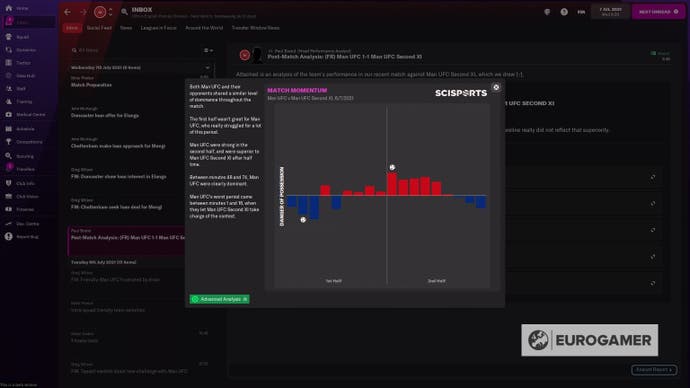
It also has knock-on effects to how other things work in-game, and the knock-on effects are amazing. This is one of the huge successes of Football Manager's years-long attempts at capturing the spirit of the real thing, because as some guy called Jose Mourinho once said, a given tactic is a lot like a blanket that's a little too short. You can pull it up over your shoulders, or down over your toes, but you can never both, and so every strategy, and every specific decision that goes into it, is about sacrificing one consequence for another, one benefit for one cost. In FM22 those consequences are harsher, more noticeable, more pointed, your toes colder than ever.
The big example Sports Interactive likes to offer for how this ties into the new animations is pressing. More freedom of motion for players means their movements can be more freely impacted by your tactical preferences, and the whole system of how your team presses has been reworked to reflect that (and, probably, to make sure it's a little more balanced). Much the same as how an Antonio Conte might scream at a player for being half a yard away from their man and march onto the training pitch to reposition him, you now have to pay attention - a lot of attention - to the little details if you want your press to really work at the highest level. This means the obvious things like the line of engagement and defensive line, but also the defensive width is more of a strategic tool than a literal one. Previously, in my experience, it bas a basic trade-off between trying to stop crosses and wing play, at the expense of being stretched and easier to play through centrally, and so I'd set my team up to press aggressively, but still show players outside on the defensive because I backed big old slabhead Maguire to win any headers from those extra balls into the box.
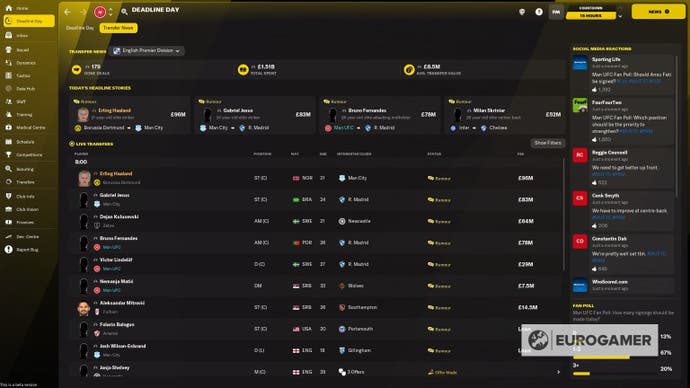
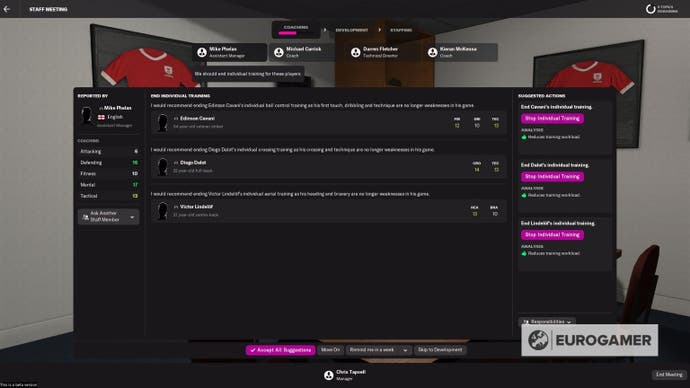
Now, at least in theory - this stuff takes real-world months to pin down, I find - it's seemingly more about the directions from which your players approach when pressing, the angles of their body cutting off certain passing avenues and funneling play to certain areas. Opposition instructions, too, now factor into this much more. I always found these slightly vague, more of a trap to fall into, where you can set your players up to do something contradictory just by taking the advice of your gormless assistant manager, and I still do to some extent - but a lesser one, crucially.
The intention now is for them to reflect your overall pressing approach. Wording has been rejigged to reflect the modern lexicon - pressing triggers are the new name, rather than whether or not to simply "close down" a player - and the objective is more for you to use these instructions to tie into the whole tactic. If you want to press a team down to the touchline, then use a narrower defensive setup then it's not a good idea to show a left-footed left-back onto their weaker foot, because that'll get your players running at them from an angle that opens up the inside of the pitch. Still a bit of a trap, then, but one that does make a bit more sense.
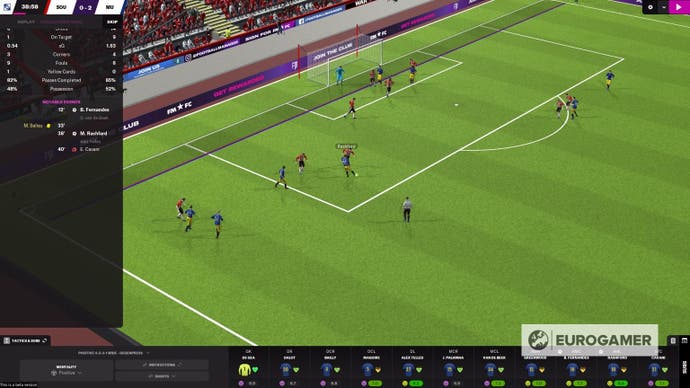
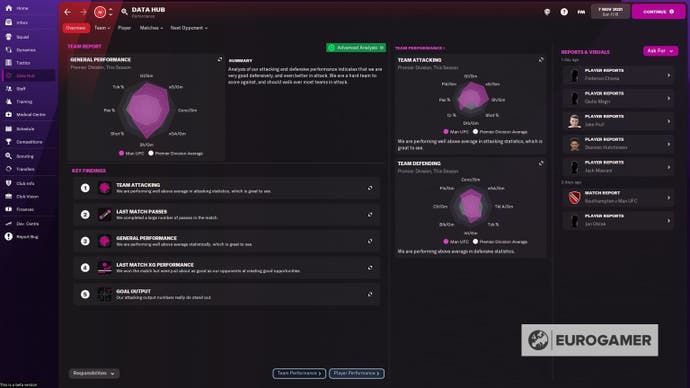
More importantly, stamina - or the lack of it, in plenty of cases - is now much more impactful. AI improvements mean players now have "awareness" of their own sprint capacity, which sounds a bit Judgement Day but generally just means they won't press if they're already exhausted. They also get tired much, much faster, I find - even those that can normally run all day - and although I haven't personally got to the end of my season yet, the impression is that this will only get worse as the games stack up, with my players, despite some heavily micro-managed rotation, already brushing up against some accumulated fatigue.
Had this system been added to FM21, I would have been worried. FM21 brought some brilliant new data analysis systems into play - notably the obvious one, expected goals, but also a few others that span off from that - but in terms of actual, actionable data beyond the broad strokes of knowing whether you're creating enough chances or conceding too many, things hit a bit of a limit. Building on the foundations of last year, FM22 adds a new Data Hub, its other big headline addition (with apologies to the new Overlapping Centre-Backs - you guys are neat but I am allergic to playing three at the back).
The Data Hub is excellent. For the first time in as long as I can remember, there are actually more features than I could reasonably think of using. A key one for me, as I toiled away with my early-season pressing experiments, has been the one which visualises where you lose most of your possession, and another for where you gain it back. Different management styles for different teams will care about different types of analysis, but for my own attempts at pleasing a fussy board with attacking football, while also trying to actually win, figuring out why I can't keep hold of the ball, despite my players' high passing ability, has taken some proper detective work. The magic is knowing the information is actually there for you, if you know where to look.


Beyond that, there are a few other big, key changes. One that I can't say I love is Deadline Day. Upon this most holy of footballing days, the game is now splashed in the sensory assault of Sky News' signature danger yellow. Annoyingly for the type of football fans who loathe the vapid, nauseating money-worship of the real-world game (yes I know I support Manchester United), and again just like the real thing, it is actually quite fun to play through, with a whole dedicated centre for last-minute transfers and a genuine sense of bustle and temptation to the game. It is bad for football and frankly bad for human beings that we care about this sort of thing, that Fabrizio Romano is so many fourteen-year-olds' new messiah, that News Corp has won. But it is a fact of life. And it is quite fun.
Speaking of nauseating, agents are now more prominent than ever - agent conversations, added last year, were a bit of a cheat code, allowing you to get some handy knowledge about asking prices and a player's interest in moving to you but with little tradeoff or consequence beyond that one interaction. Now there is a tradeoff - talking to an agent, you can sign off with either a half-promise to buy the player, or a "not interested". Saying the former without swiftly following up with a big offer will annoy the agent. Saying the latter will annoy the agent. My deeply indecisive self could do with something a little more non-committal either way, as it's frustrating to be put into a binary choice that seems somewhat arbitrary considering I could just say "We'll think about it" in the real world - but, from a pure gameplay perspective it makes sense. There is now a consequence to calling up every agent in sight to ask about players - you have to be ready to put your money where your mouth is.
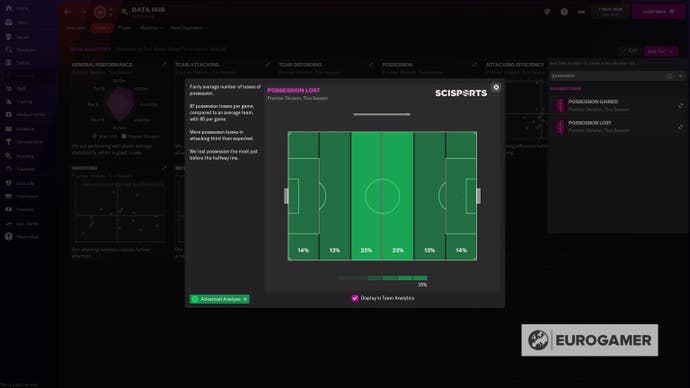

On that note comes the other two of the smaller tweaks. Transfer values, pleasingly, are now representative of what the selling club will demand for the player - i.e., their actual value, economically speaking - as opposed to an arbitrary number independent of both what you're willing to spend and they're willing to accept. Scouting reports, less pleasingly, now include analyst reports within them. Compared to the Data Hub business, I'm honestly underwhelmed by what analyst reports offer in Football Manager, and have been since they were introduced some years ago. They're a small thing, but they need a little revamp, as right now the most significant info they might provide is that the new centre back you're sniffing around is the 7th-best in his league for winning headers. What that immediately tells me is: it would be useful to know who the six players are that are better at winning headers; what it doesn't tell me is who those six players are, or where (if anywhere) I can find that out.
Still, that's a miniscule gripe amongst a sea of big, impactful, brilliant new changes that all, ultimately, come back to my point about poor Mr. Solskjaer. Since the introduction of the potentially all-consuming training revamp a couple of years ago, Football Manager has rewarded you for your obsession, although it is still functional enough for those who want to tell the team to just go out and express themselves.
Now, with FM22, it's taking that to another level. In an ideal world, maybe it could build that training revamp into it - adding a few more Endurance sessions doesn't quite match the intensity of Pep Guardiola dividing the entire pitch up with cones and drilling that grid into each of his players' deepest subconscious. But we are getting there. The "headless chickens" gegenpress of old just doesn't work anymore. You might get through a few matches early on, just about , but there will be a whiff of uncertainty to things. A sourness to the taste of victory. A bit of a glass jaw that starts to show through the flagging guard. A sense of impending doom.
Like in the real world, the ultra-high press occasionally leads to a battering - not just in aberrations like that United-Liverpool game but in all the other not-so-freak results we've seen recently. The Aston Villa 7-2 Liverpool game, the 7-0 Bayern Munich win over Barcelona, the 7-1 Germany win over Brazil. Like in the real world, in FM22 it now takes an obsessive, perfectionist manager to scrub those blemishes out, and like in the real world it takes a huge amount of high-quality data to back it all up. It's not impossible, but in Football Manager 2022 it's definitely harder to survive at the top on nothing but vibes. And it's more blissful than ever to compulsively clean up my own club's mess.
